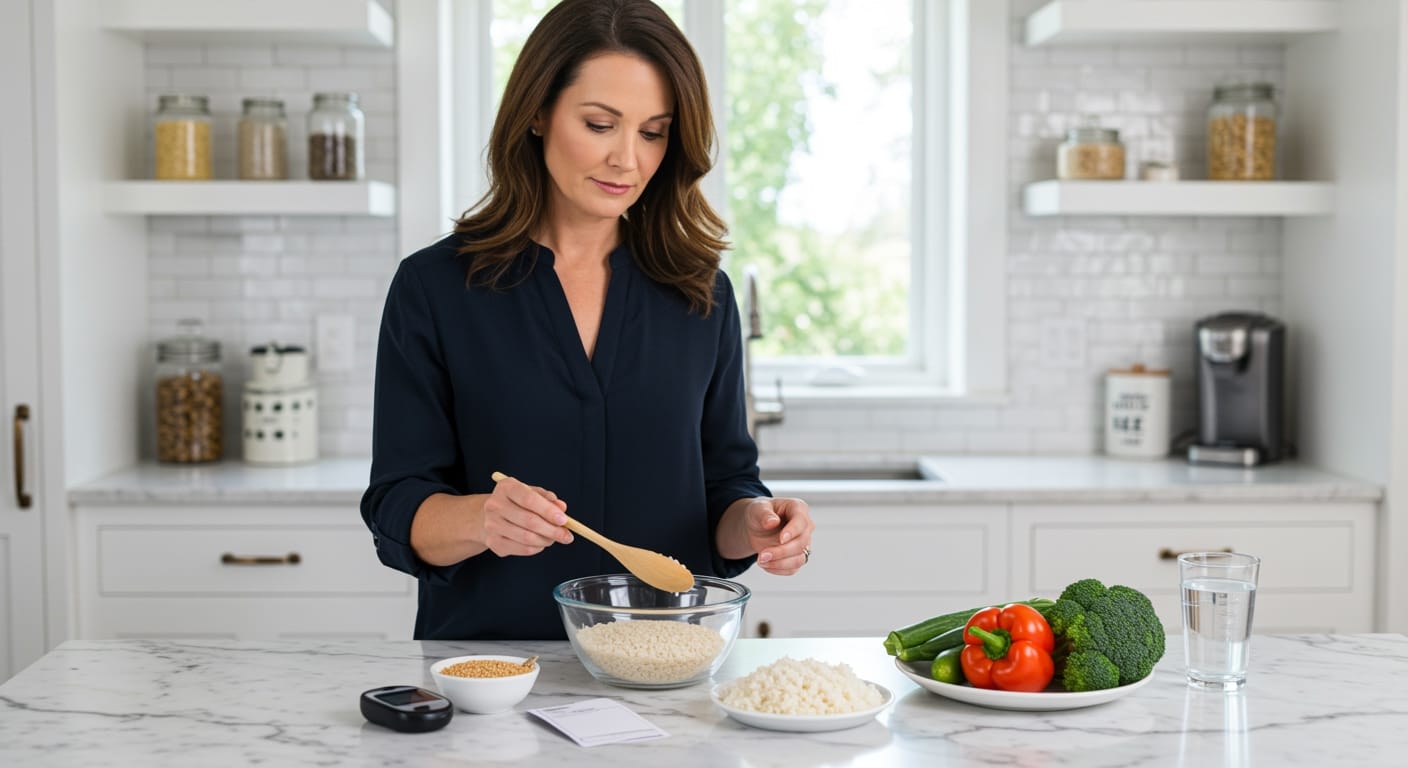✪ Key Takeaway: White rice can be part of a diabetes-friendly diet when eaten in proper portions with protein and fiber.
Introduction
White rice sits on dinner tables around the world, yet it carries a reputation that makes people with diabetes nervous.
You might be asking this question because your doctor mentioned watching your carbs, or maybe you heard conflicting advice about rice and blood sugar control.
Hi, I’m Abdur, your nutrition coach, and today I’m going to explain the real relationship between white rice and diabetes, so you can make informed decisions about this staple food.
What Does Research Actually Say About White Rice and Diabetes?
Harvard researchers followed over 350,000 people for decades and found something interesting about white rice consumption.
People who ate five or more servings of white rice per week had a 17% higher risk of developing type 2 diabetes compared to those who ate less than one serving per month.
However, this study looked at regular high consumption over many years, not occasional moderate intake.
The key finding was not that white rice is inherently dangerous, but that eating large amounts frequently without balancing nutrients creates problems.
Asian populations who eat rice daily but maintain traditional eating patterns with vegetables, fish, and smaller portions show different diabetes rates than Western populations eating rice as a side dish with processed foods.
Context matters more than the food itself when we look at real-world eating patterns.
✪ Fun Fact: Japanese people eat rice daily but have lower diabetes rates than Americans who eat rice occasionally.
How Does White Rice Actually Affect Blood Sugar?
White rice has a glycemic index of around 73, which means it raises blood sugar faster than foods like oats or beans.
But glycemic index tells only part of the story because it measures foods eaten alone, not as part of mixed meals.
When you eat white rice with protein like chicken or fish, the blood sugar response becomes much more moderate.
Adding vegetables and healthy fats further slows down sugar absorption, creating a gentler rise in blood glucose.
The portion size makes the biggest difference in blood sugar impact – a half cup of cooked rice affects you differently than two full cups.
Your individual response also depends on factors like physical activity, stress levels, and when you last ate.
Many people with diabetes successfully include small portions of white rice in their meals by monitoring their blood sugar response and adjusting accordingly.
✪ Pro Tip: Test your blood sugar 2 hours after eating rice to understand your personal response.
Are There Better Rice Options for Blood Sugar Control?
Brown rice contains more fiber and nutrients than white rice, which can help moderate blood sugar spikes.
The fiber in brown rice slows digestion and provides a steadier release of glucose into your bloodstream.
Wild rice offers even more protein and fiber while having a lower glycemic impact than both white and brown rice.
Cauliflower rice has become popular as a low-carb substitute, providing volume and satisfaction with minimal blood sugar impact.
However, switching rice types is not always necessary if you can manage portion control and meal composition effectively.
Some people find that cooled and reheated white rice has a slightly lower glycemic impact due to resistant starch formation.
✪ Note: Resistant starch forms when rice cools, which can help improve blood sugar response.
What Are the Smart Ways to Include Rice in a Diabetes Diet?
Start with portion awareness – a serving of rice should be about the size of your closed fist or half a cup cooked.
Always pair rice with lean protein like grilled chicken, fish, or tofu to slow down sugar absorption.
Load your plate with non-starchy vegetables first, then add your rice portion as a smaller component of the meal.
Timing matters – eating rice earlier in the day when you are more active helps your body process the carbohydrates more effectively.
Consider the plate method – fill half your plate with vegetables, one quarter with protein, and one quarter with rice or other starches.
Monitor your blood sugar response to different rice preparations and adjust your approach based on what works for your body.
Some people do better with rice at lunch rather than dinner, while others find smaller portions throughout the day work best.
✪ Pro Tip: Use a smaller bowl or plate to naturally control your rice portions without feeling deprived.
The Bottom Line
White rice is not inherently bad for diabetes when consumed mindfully as part of a balanced diet with appropriate portions.
As I always say, “No single food makes or breaks your health – it is the overall pattern of eating that determines your success.”
I would love to hear about your experiences with rice and blood sugar management, or any questions you might have about making this work in your daily routine – please share your thoughts in the comments below.
References
At NutritionCrown, we use quality and credible sources to ensure our content is accurate and trustworthy. Below are the sources referenced in creating this article:
- Harvard T.H. Chan School of Public Health: Eating white rice regularly may raise type 2 diabetes risk
- Glycemic Index Foundation: White Rice Glycemic Index
- USA Rice Federation: Can you eat white rice if you have diabetes
- PMC – National Center for Biotechnology Information: Rice consumption and risk of cardiovascular disease
- JAMA Internal Medicine: White rice consumption and risk of type 2 diabetes





